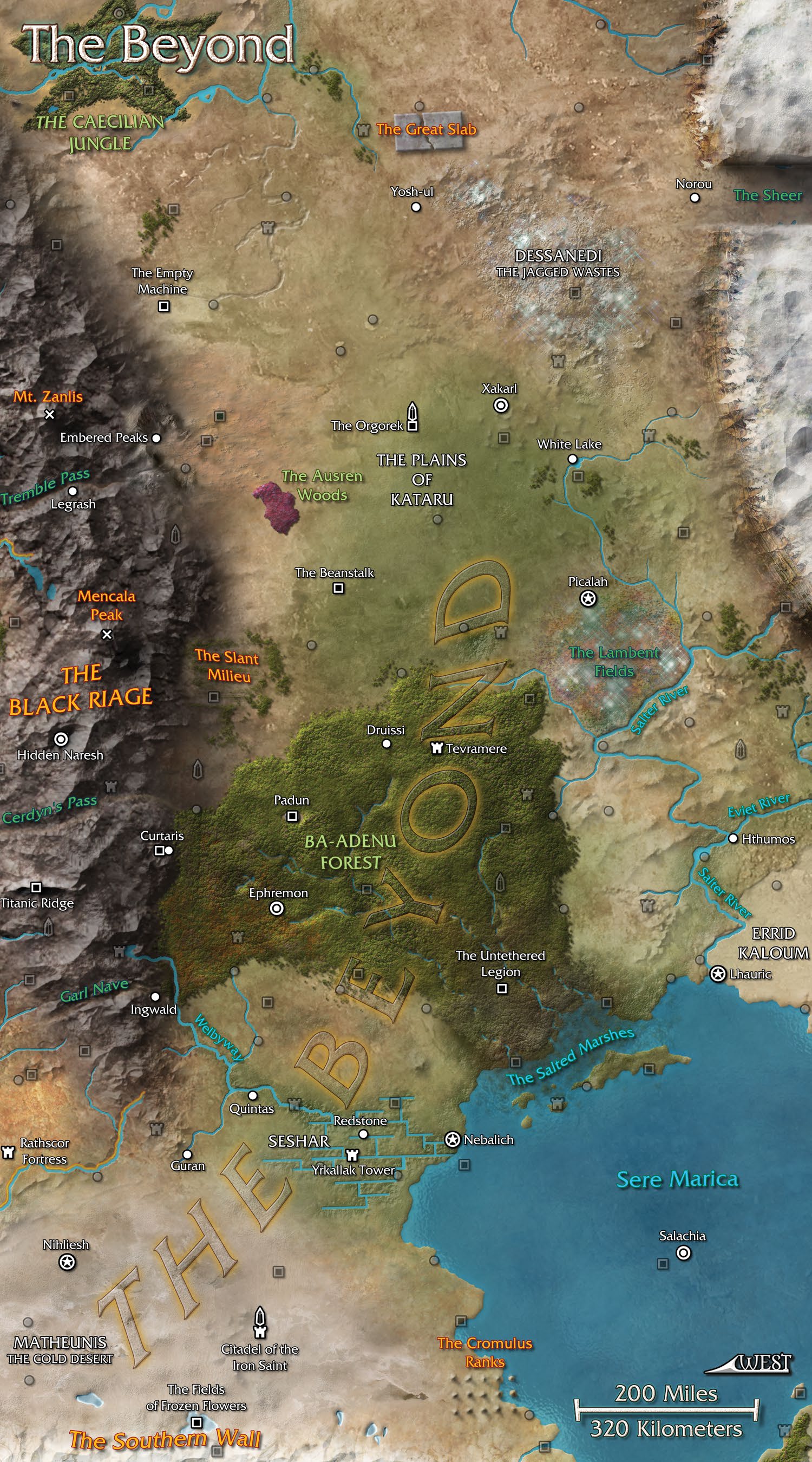¶ World Map
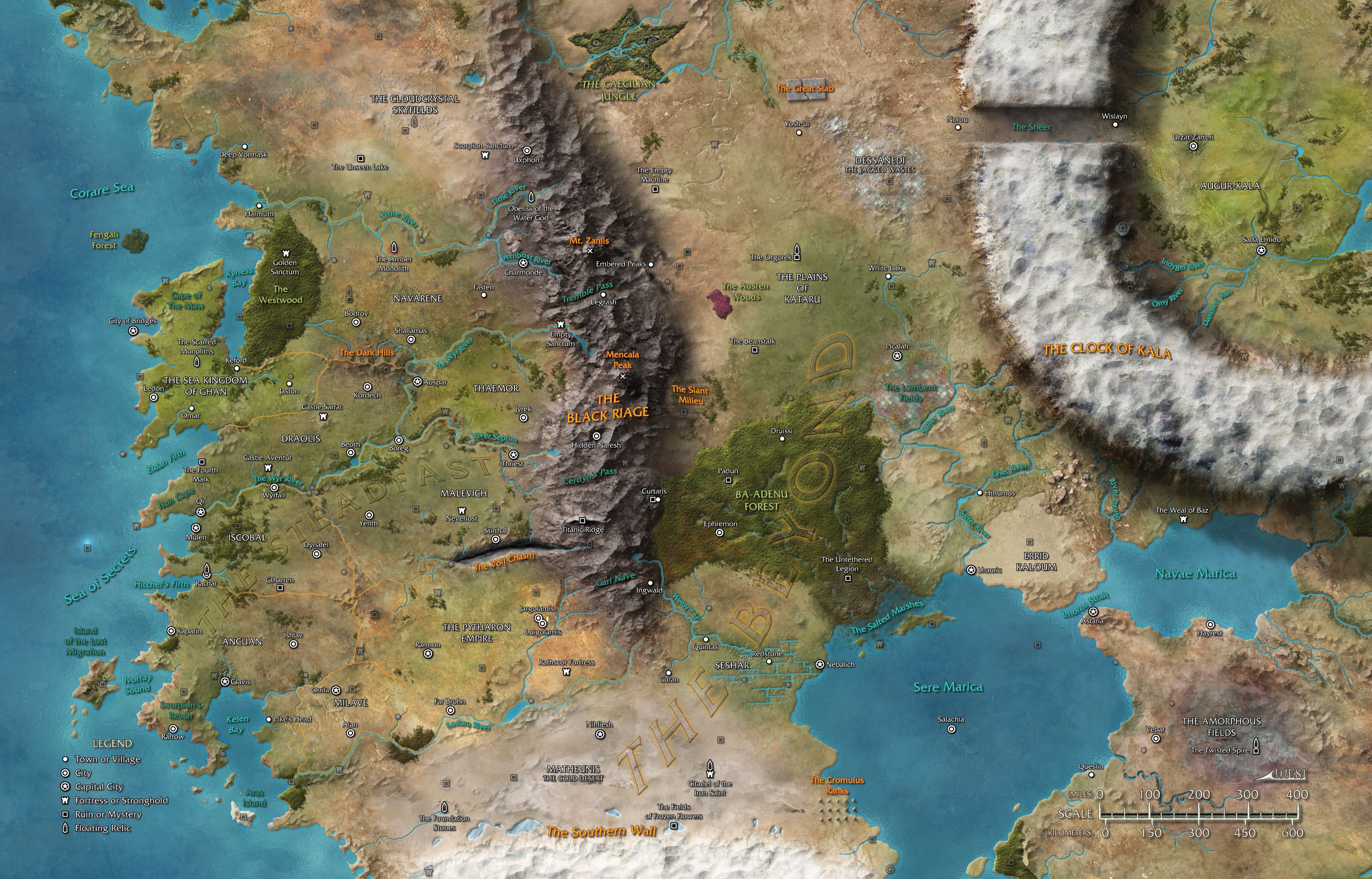
¶ The Steadfast
The Steadfast comprises nine different countries. Collectively, the rulers are often called the Nine Rival Kings, or just the Nine. These kings, queens, princes, and councils share no love for one another and truthfully have no relationship except that each rules over a land whose people owe faith and favor to the Amber Papacy.
Generally speaking, the Steadfast is more settled and civilized than the Beyond, but it can be just as dangerous. Communities are isolated. Travel on the roads is risky and nearly unthinkable at night—but at least the roads exist.
The Steadfast includes all the land from the sea to the Black Riage, south of the Tithe River and north of the Sadara. The nine kingdoms of the Steadfast are Navarene, Ghan, Draolis, Thaemor, Malevich, Iscobal, the Pytharon Empire, Milave, and Ancuan.
¶ Navarene
Ruler: Queen Armalu
Population: 1,500,000
Capital: Charmonde
Navarene is one of the largest and most prosperous kingdoms in the Steadfast. Disliked by all the other lands, the people of Navarene are thought of as aloof, difficult, and even arrogant. “Wealthy as a Navarene merchant” is a saying in the Steadfast that almost always has implied negative connotations.
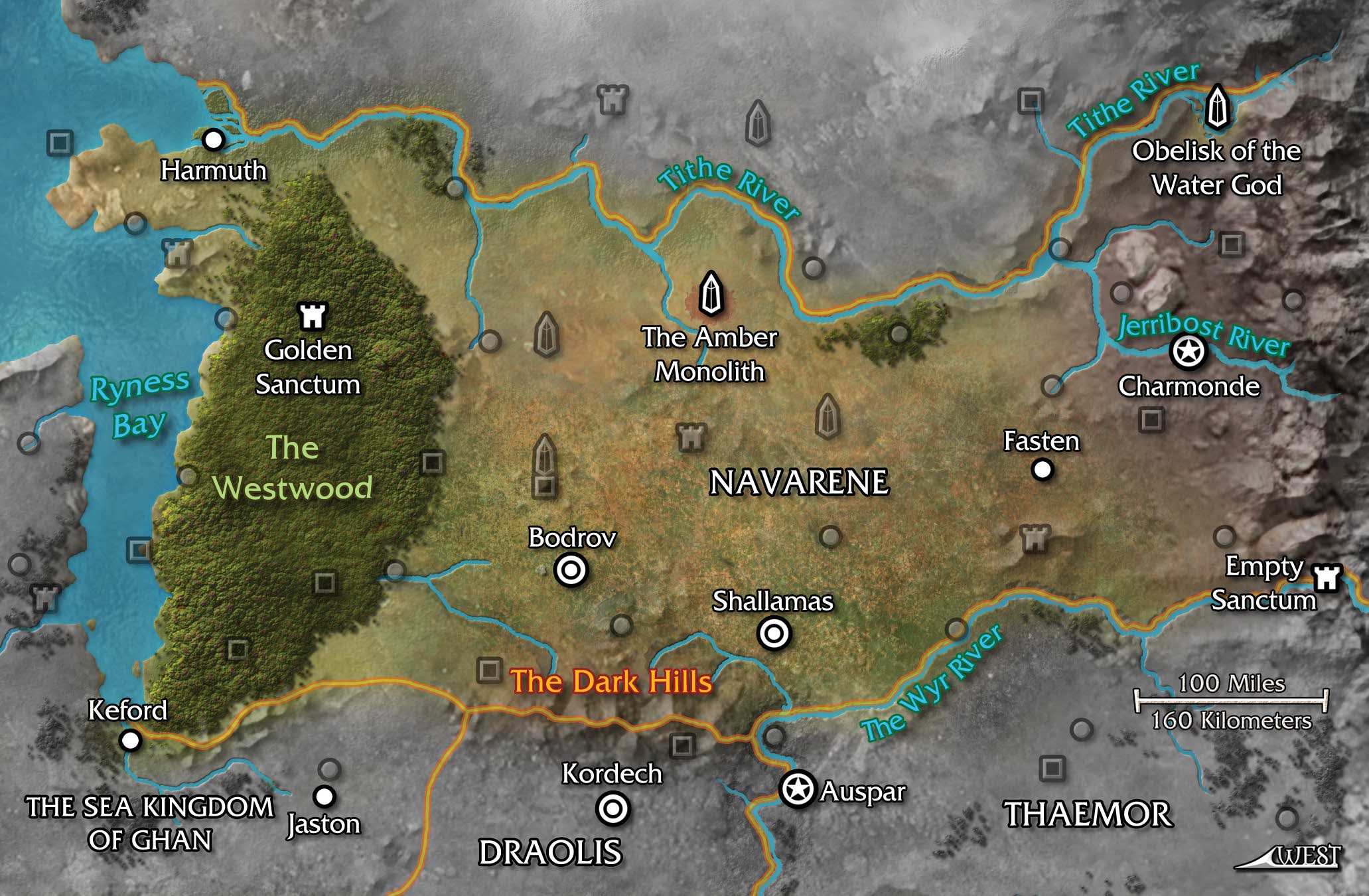
The southern part of the kingdom is known for its rich farmland. Simple farmers and herders work for wealthy landowners who in turn pay fealty to a small number of aristocratic families, each of whom answers to the queen, who rules from her capital of Charmonde. Her palace is known as the Empiternal House, and at its center is a set of sealed chambers that Queen Armalu never leaves. To come and go, her court must pass through a series of airlocks and undergo a misting spray that removes any potential contaminants. This odd but careful behavior, coupled with a variety of strange treatments and procedures, has allowed Armalu to live for 253 years—so far.
Queen Armalu is known for being both shrewd and ruthless, and her kingdom prospers as a result, for she uses these traits to best her enemies and the foes of her people. As long as her subjects are obedient and efficient, they are treated well and with a fair hand.
Navarene forms the boundary between the north and the rest of the Steadfast. Thus, the northern portion of the kingdom, south of the Tithe River, holds many forts and war-castles that help defend this border from the dangers of the Beyond. Now that the Amber Pope has declared war on the mysterious lands to the north of the Cloudcrystal Skyfields, these fortresses are even more important. Queen Armalu has petitioned the papacy to require the other eight kingdoms to pay to help maintain the bastions. The other rulers balk at funding Navarene’s military, feeling that Armalu is as likely to use it to invade them as she is to defend them from the Gaian invaders—should those infidels ever come.
¶ The Sea Kingdom of Ghan
Ruler: King Laird
Population: 1,000,000
Capital: The City of Bridges
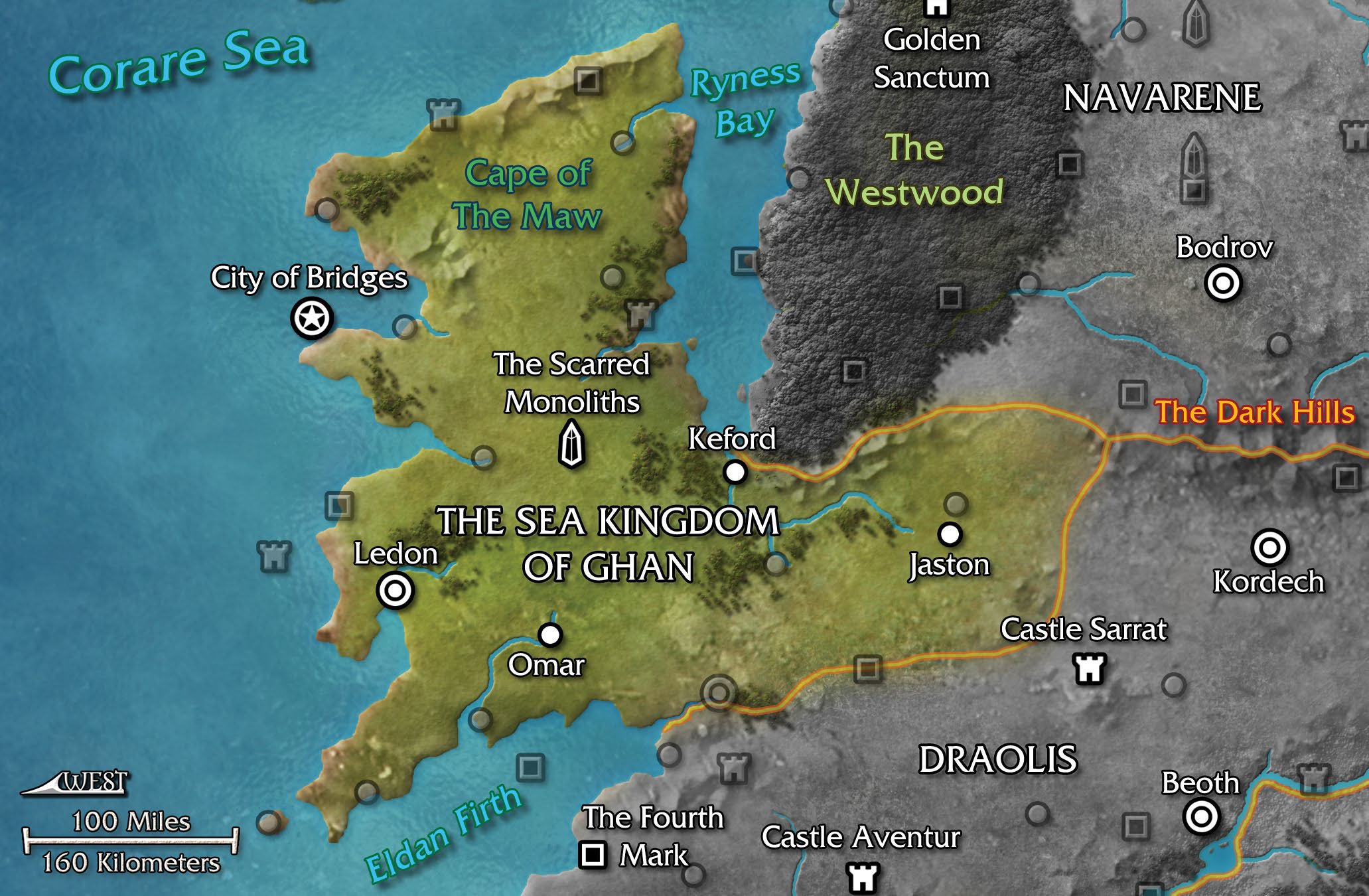
Known for its coastal trading ships, the socalled Sea Kingdom of Ghan is a relatively peaceful land. King Laird has no wish to challenge or even appear to challenge Queen Armalu of Navarene or the ruling council in Draolis, yet he doesn’t want to appear weak and ripe for the taking, either. Thus, he protects his borders and maintains a careful vigil without making aggressive moves. Most important, however, he ensures that his merchant fleet plays such an important role in the Steadfast that no one would want to suffer his kingdom’s sudden collapse—or, just as bad, his sudden refusal to maintain the coastal trade routes vital to most of the nine kingdoms.
The rolling green hills of Ghan are known for herds of gallen and aneen. Gallen are long-bodied, herbivorous animals valued for their meat and hides. Aneen stand two to three times as tall as a human, with hunched, hairless bipedal bodies, small forearms, and broad heads. These pack animals can attain great speeds and walk tirelessly for long distances. Many trade caravans in the northern part of the Steadfast use aneen to transport goods or pull massive wagons.
King Laird lives in the Coral Palace off Ghan’s coast, a part of the City of Bridges. Ghan has little in the way of an aristocracy. Most of the people are free citizens owing fealty only to their king. Few people own slaves. Governors and mayors rule over districts and towns, but the organization is varied and unofficial. Seafarers and herding folk, Ghanites do not abide a strong government, and King Laird is happy to oblige them.
Look long, my friends. Look hard.
Greener hills, bluer waters you’ll never find
than those of my heart, in the kingdom by the sea. Look long, my friends.
Look hard.
Finer men, prettier smiles you’ll never find
than those of my heart, in the kingdom by the sea. —The Song of Ghan
¶ Draolis
Ruler: Council of Spheres
Population: 2,500,000
Capital: Qi
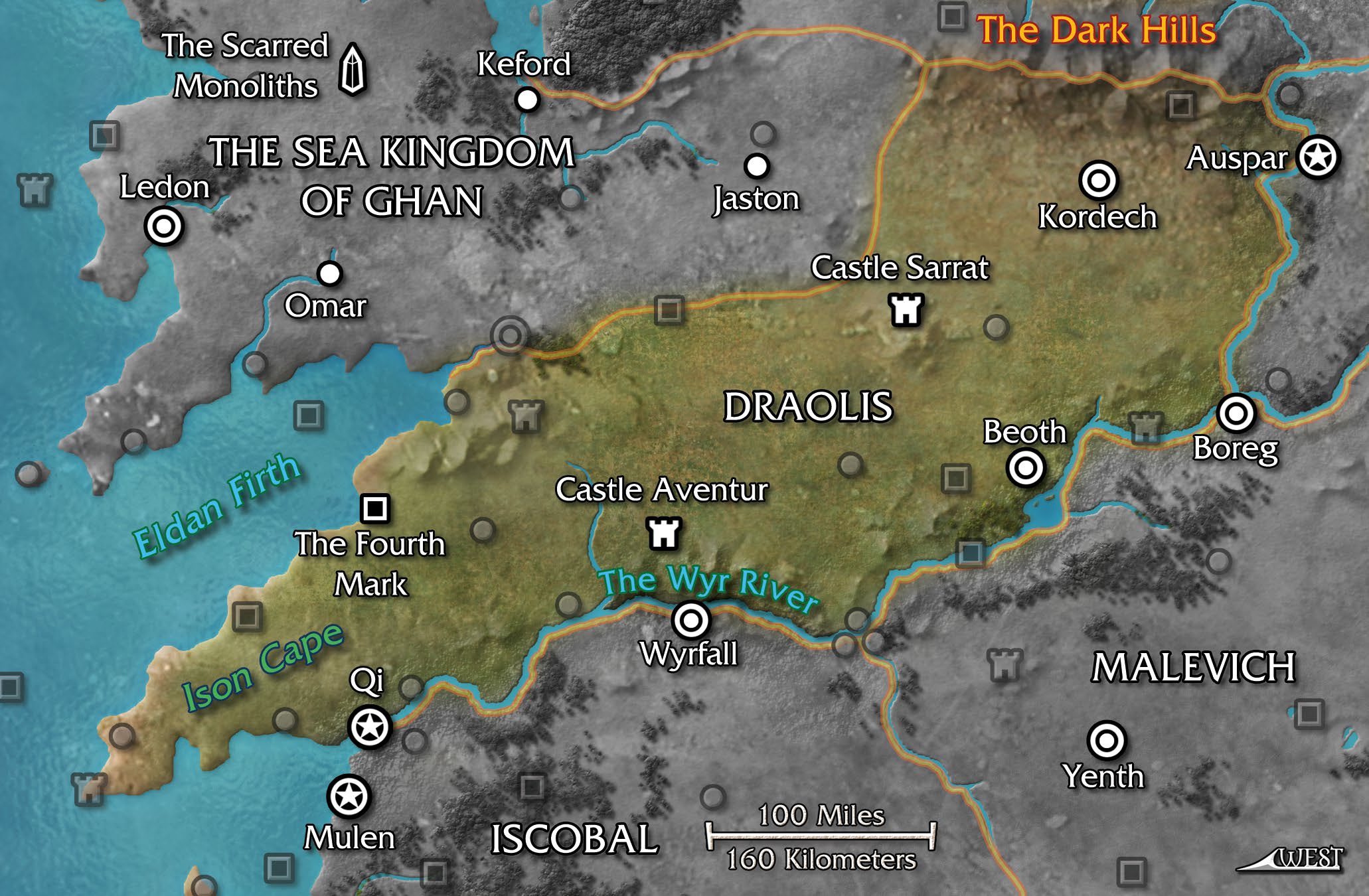
Draolis is the most populated land in the Steadfast and also one of the wealthiest. Its banner depicts six interwoven spheres, but most people refer to it as the Tiger Banner. Centuries ago, Draolis was home to a powerful queen who ruled the land with a firm hand. Her symbol was a roaring tiger, and her armies crushed all those around her. When her line died out, power in Draolis was seized by a council of wealthy plutocrats who didn’t want another hereditary monarchy to take control. The Council of Spheres abolished the tiger symbology, but many people remember the tales from that time and long for that former glory.
Although the council lacks the flair of the tiger rulers of the past, Draolis has not abandoned its ways. The nation remains a military power, with might comparable to that of its chief rival, Navarene. In fact, the Order of Truth is the only thing that keeps these two countries from warring openly.
¶ Thaemor
Ruler: Holiva the First
Population: 900,000
Capital: Auspar
One of the smaller and least prosperous kingdoms in the Steadfast, Thaemor is often overshadowed by its neighbors. In fact, the other kingdoms consider it something of a joke.
That wasn’t always so. Bordered by two rivers and a mountain, Thaemor was once an unnamed but very much desired piece of land, part of a three-way war between Navarene, Draolis, and Malevich. Each power wished to lay claim to the fertile triangle.
In the midst of the struggle, one man took it upon himself to claim the place he later named Thaemor. Goldguard Landon was a fearsome warrior who knew everything about how to defend a region from the onslaught of multiple kingdoms but absolutely nothing about running a kingdom himself. Under Landon’s rule, Thaemor’s borders were always well protected and cared for, even from the mightiest foes, but the same could not be said for the people and places within.
After Landon’s passing, his son Kaldon took hold of Thaemor and ran it (if you could call it such) much as his father had. He sired a number of children, but none of his heirs survived, and when he died, a man named Holiva the First took office in the Precipice, although no one can quite remember where Holiva came from or what skills qualified him to rule.
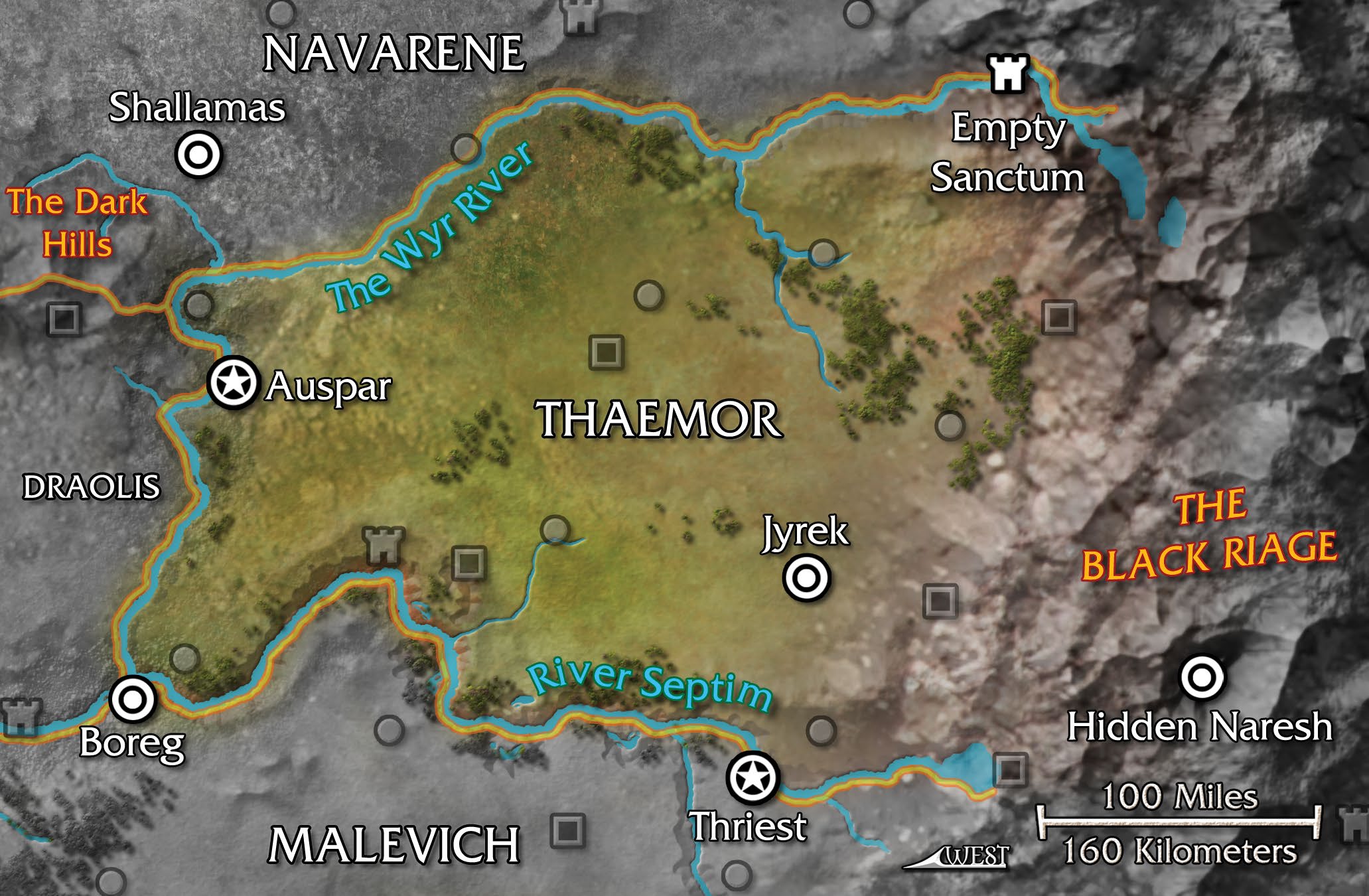
Today, the way in which other kingdoms look down on Thaemor is a source of pain and embarrassment for Holiva, for he believes that his kingdom could be a land of great power and opportunity if only others could see what he sees.
Unfortunately, what he sees is very little that is real or true. Although Thaemor is a region of deeply buried riches, clear waters, and fertile lands that have not yet come to fruition, Holiva sees none of that. He doesn’t see the intelligent, hardworking people or their potential to be great leaders, teachers, warriors, and scholars.
Instead, everything Holiva sees is viewed through the shadowy lens of his vizier, the Hand of Melch, and the Hand urges him toward only one thing: the restoration of the shadow herd. “The shadow herd,” the Hand tells him, “is a group of dark, formless creatures, born of a wicked mind older than the kingdom itself. Free them, and it is they, they, who will help Thaemor become what it once was. They who will help the whole of the Steadfast—nay, the whole of the world kneel before Thaemor’s feet and crown your head with glory.”
Holiva believes what the Hand tells him. There’s only one problem: the hand that Holiva listens to is his own. The man spends his waking hours talking with his own body part in the form of a shadow puppet. He mostly stays awake through the night, when glowglobes provide the most clearly defined shadow puppet and thus when he believes he can hear the advice of his vizier most truly.
While Holiva pools all of his country’s resources toward the single purpose of reviving the shadow herd, the people of the land work deftly and silently beneath his clouded gaze. After having successive rulers with little to no skill in leadership, the people of Thaemor have learned to become self-sufficient.
Of course, no one whispers that Holiva the First might have lost his sanity long ago—that would be treason. And no one whispers of the ancient time when the shadow herd thundered across all the lands tucked in the shade of the Black Riage—that would be superstition.
¶ Malevich
Ruler: King Yorvic (Regent Allabon)
Population: 1,200,000
Capital: Thriest
Known for bleak landscapes and people tested by hardship, Malevich’s tale is one of war and would-be conquest. Yet after crushing defeats in decades past, its warlords are now quiet. Yorvic, the current king of Malevich, is no bloodthirsty despot, as was true in previous generations. He is, in fact, a three-year-old boy. His cousin Ellabon serves as regent and likely will continue in that role until young Yorvic passes through the ritual of second birth at age thirteen.
Numerous villages dot the landscape of Malevich. These farm communities are usually small and poor, little more than thatch-roofed huts gathered in defensive circles around a communal pen for the shaggy goats they tend. Mud-stained boots walk down rough roads infrequently—the folk of this dark land remain in their isolated villages if possible. They bar the doors at night and pray to vindictive yet seemingly indifferent gods.
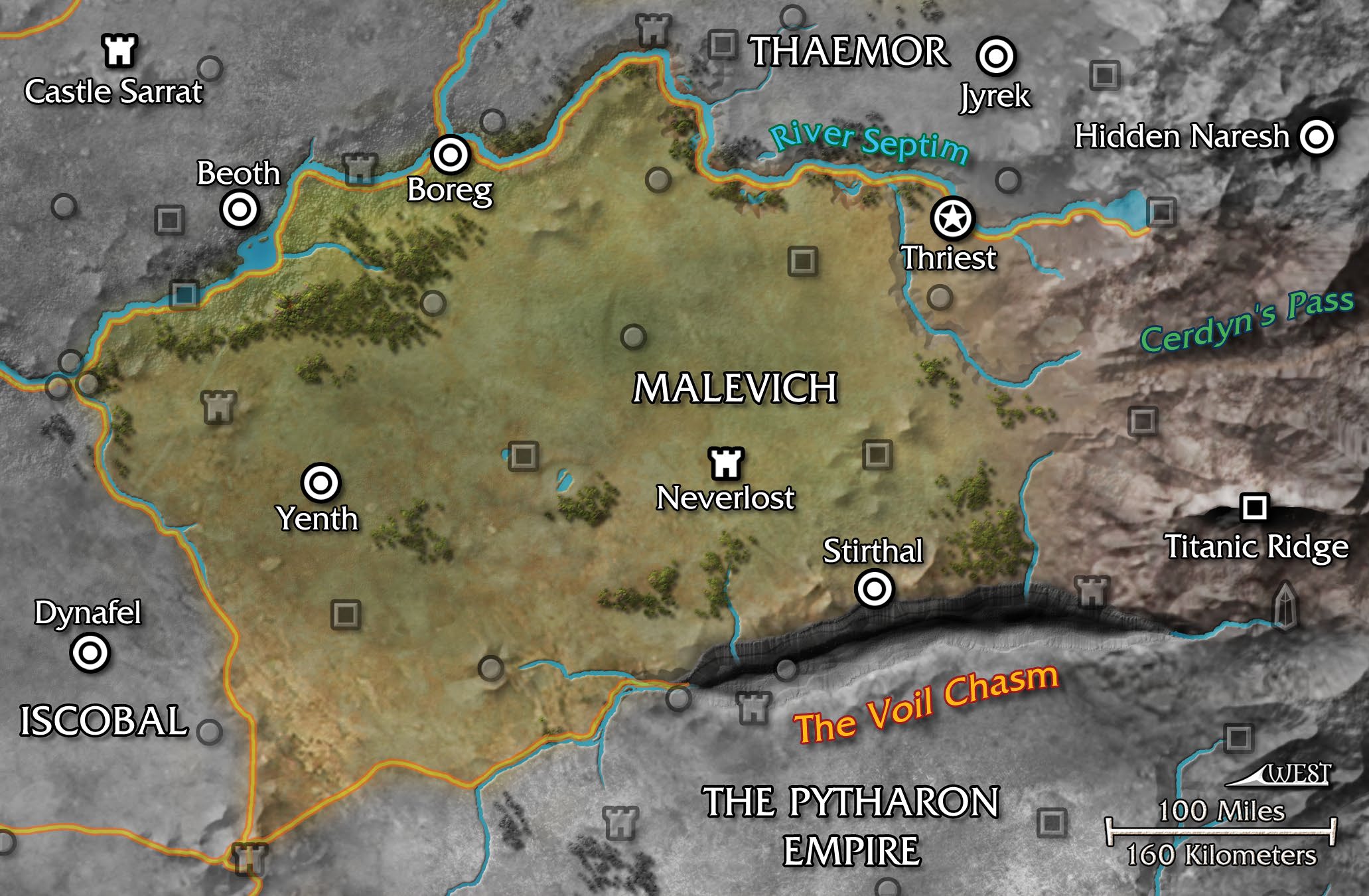
Their fear is not misplaced. Malevich is threatened at all times by bands of abhumans and clans of bandits. The former roam in small unorganized groups, while the latter, under the command of the Bandit King, Polele, are frighteningly unified and organized. Many of Polele’s warriors are veterans of Malevich’s past wars, aged men with few skills that don’t involve blades and blood. Rumor has it that the bandit clans have offered to do mercenary work for foreign kings in other lands. Whether this is good or bad for Malevich—if it’s true at all—is yet to be determined.
Malevich nobles ride in tall, armored chariots pulled by abhuman and human slaves. They own what little wealth the kingdom has, while the peasantry lives on the edge of starvation.
A fantastically huge rift known as the Voil Chasm serves as the country’s southern border. This rent in the earth is 25 miles (40 km) wide in places, but it narrows as it descends. Throughout most of its western reaches, the chasm is about 1 mile (1.5 km) deep. However, it has never been fully explored, and although the deepest point yet reached is more than 10 miles (16 km) below the surface, the chasm is known to cut far deeper in places.
Some call the Voil Chasm by its older name, the Earthwound. Legends say that it was created when the inhabitants of the prior aeon waged war with invaders from another world. The invaders used a weapon of untold power, destroying multiple cities of significant size and influence in an instant. A few people speculate that these foes tried to destroy the entire planet by drilling deep into the world’s core, like an assassin attempting to stab his victim in the heart. If true, the attempt obviously failed, but it suggests that the Voil Chasm might be deeper than most thought possible.
The chasm divides Malevich and the Pytharon Empire. Even though both lands have dreamed of conquest, the gulf between them has prevented them from coming into direct conflict.
¶ Iscobal
Calm and serene, you will find no place more lovely than the land of Iscobal, jewel of the Steadfast, I can assure you of that. The goodly king of Iscobal dwells in Mulen, a great coastal city whose glass towers glimmer equally in the light of both sun and moon. Beyond its walls, gentle farmers tend crops of golden wheat. The rivers teem with fish and the woods with game. Noble knights watch over the people of fair Iscobal, whose roads are safe and every village and town happy and content. Blessed by all the gods unseen, Iscobal is a paradise on Earth.
—The Journals of Sir Fabithan of Mulen (when this passage was written, seventy-five years ago, it may have been somewhat true)
Iscobal is a land tearing itself apart from within. Internal politics keep the nation focused on itself rather than on the dangers of the expansionist kingdoms at its borders. The palace intrigues involve the royal family, led by King Noren tiKalloban. Noren’s father, Rabbar tiKalloban, seized the throne about forty years ago from Queen Whenith Sarromere, whom most believed unfit to rule. The deposed queen died in exile in the land of Ancuan. Now, her sons Bren and Kor Sarromere want the land back in the name of their house. To this end, they work against the king, both openly and in secret.
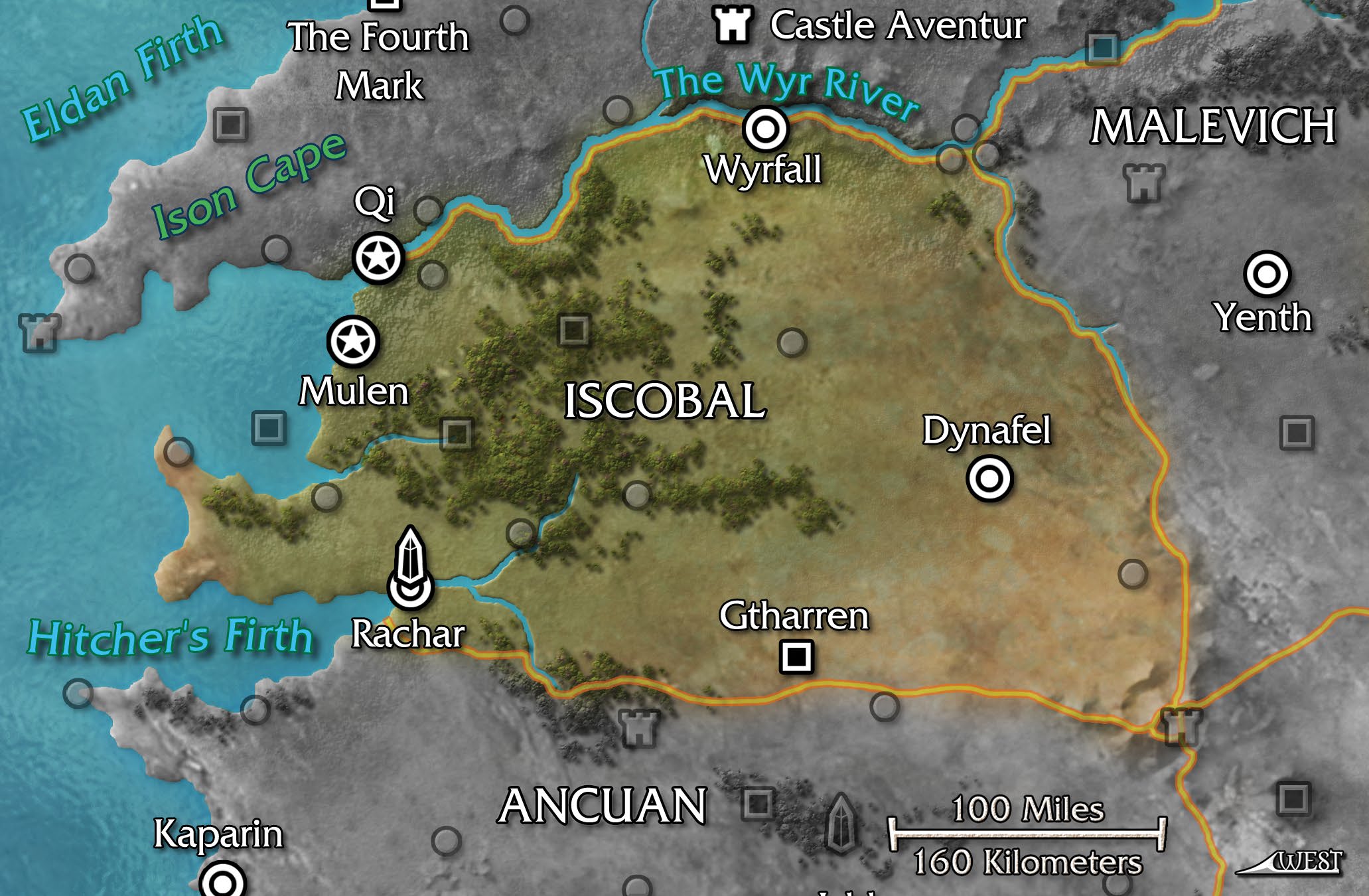
Just a year ago, an attempt on King Noren’s life left him with one eye and one arm. Only the healing power of the kingdom’s numenera stockpile saved his life. No proof could link the assassination attempt to the Sarromere brothers, but few in the kingdom have any doubts on the matter. Queen Thera has taken it upon herself to organize the kingdom’s secretive Masked Legion to combat the Sarromere family in the shadows even as her husband opposes them in court.
During her strange reign, Queen Whenith Sarromere had become convinced that by using a variety of numenera secrets, she could harness the power of dreams to control the minds of all who might oppose her, inside and outside her borders. Eventually, she gave up on this scheme, but only because she began to believe that within dreams lay an entirely different realm that she could rule instead of the corporeal land of Iscobal. With each capricious and bizarre idea she had about sleep or dreams, she issued rewards to explorers who scoured the Ninth World for devices and knowledge related to those topics. She commanded her scholars and Nanos to experiment with the sciences they understood to make her dreams—literally—into reality.
The people of Iscobal are farmers and fishers. The former raise wheat, beans, and cotton, as well as tend orchards of orange billam fruit. The latter use small round boats called skitters to travel up and down the coast and down the mighty Wyr River.
Iscobal is also known for its abundant game. Hunters provide a great deal of fowl and venison to feed the population.
Ruler: King Noren tiKalloban
Population: 1,000,000
Capital: Mulen
¶ The Pytharon Empire
Ruler: Challadien III
Population: 2,000,000
Capital: Rarmon
Possibly the oldest of the Steadfast kingdoms, the Pytharon Empire once commanded most of the southern region, including Milave, Iscobal, and Ancuan. Although the empire collapsed almost a hundred years ago, it regained its footing and began to prosper under the previous empress, Challadien II. She consolidated old holdings into Imperial rule again under the auspices of protection.
Now the new, relatively young empress, Challadien III, hopes to extend her aunt’s successful reign. Most believe she has her eyes on lands that once were part of the empire, in particular Milave and Iscobal, and perhaps seeks to spread her influence over lands to the south.
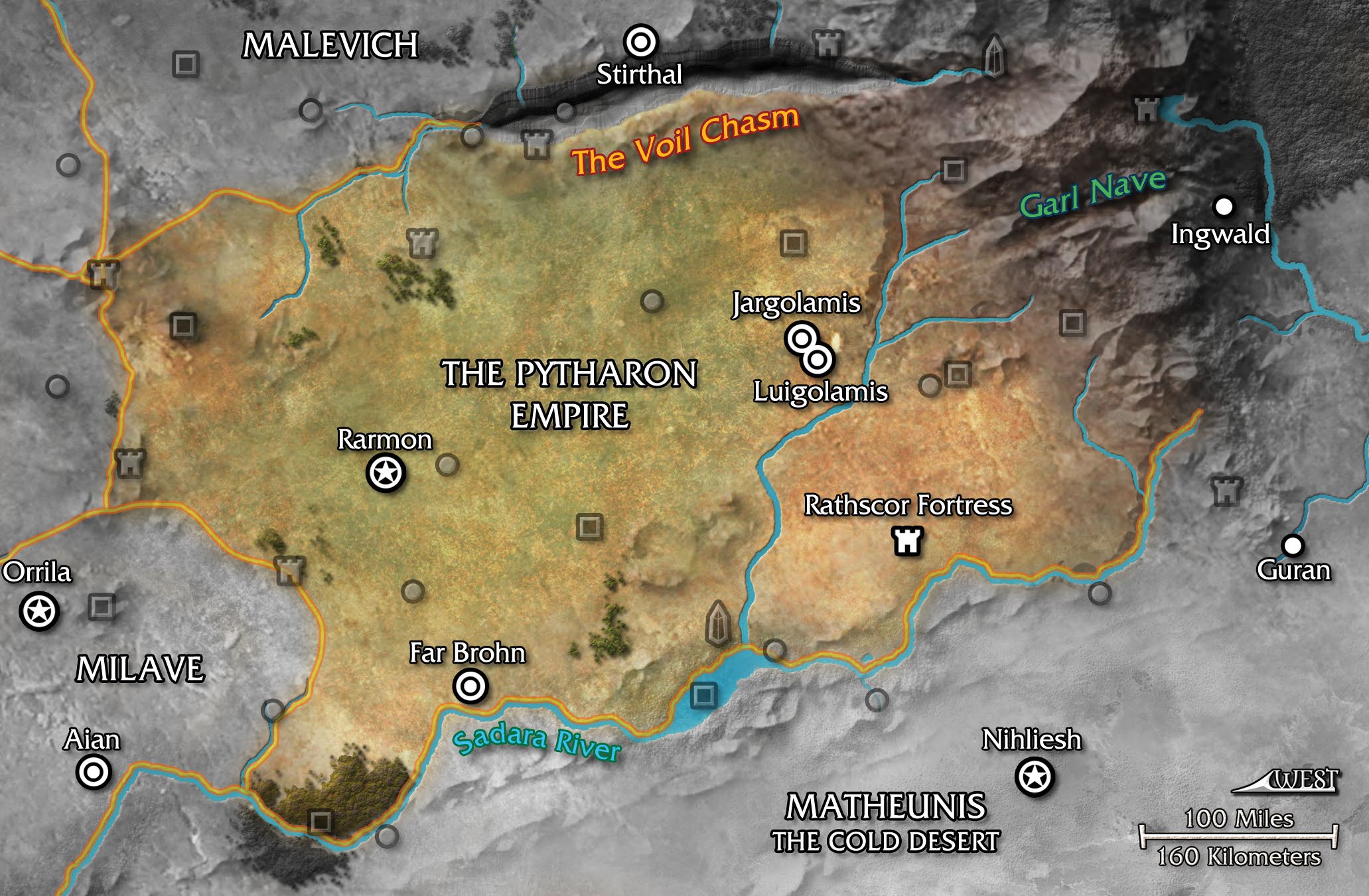
The Pytharons are well aware that the regions of Matheunis to the south are far more settled than they once were. These free realms, including the powerful city-state of Nihliesh, feel the gaze of the empire upon them. Pytharon nobles already send their troops down there to raid for slaves.
Pytharon is known for gently rolling fields of wheat, beans, and corn. Its fertile lands were once a great part of its success and could be again, for its ample so-called “breadbasket” has fueled great armies.
My dear and loyal subjects,
Your beloved Empress, Challadien II, Lady of the Southern Reach, and Queen of the Riage, wishes you to know that the days of foul banditry and lawlessness that have plagued these lands have come to an end. The peace-loving forces of the invincible grand Imperial armies, under my direct command, shall restore this realm once again to a land of prosperity and peace. You and your families shall be safe under their banner. Your children are like unto my own, and my own desire is for their happiness and good health. The integrity of your lands, your homes, and all of your belongings shall be secured under our banner. Those who stand in the way of this generous and beneficent gift of safety, however, are naught but robbers and undesirables, and shall meet our swift judgment.
¶ Milave
From Nomilla Eron, Milavian noble:
Once Milave was a region of the Pytharon Empire, when its red banners flew from every tower in the South. Now that name is given to a loose confederation of small noble states and even a few so-called republics. The latter, of course, are nothing more than backwater counties too wretched for any proper noble family to desire position, and where the merchant classes give the peasantry fool-headed ideas of ruling themselves.
The only thing that truly binds Milave together is fear of invasion by the empire. Milavians have few similarities, but a memory of the hard-won independence from Pytharon is one. Ostensibly, Milave is ruled by a council of representatives of disparate governments, clans, and factions who meet in the city of Orrila.
The nation will not last as a cohesive whole for long. The ruling council does little but bicker over petty matters while the nearby empire once again grows in military might. If war does come, Milave’s loose union is likely to collapse, each state fighting for itself and no other—and thus we are all doomed.
One possible savior, however, is a noble warlord named Tarvesh. This charismatic young leader has the support of many Milavians, and his personal fighting force includes three terrifying numenera war machines, the likes of which have not been seen before in the region. I suspect that Tarvesh has clandestine support from the Amber Papacy, which hopes that he can unite Milave and keep the peace in the southern end of the Steadfast. Indeed, many hopes rest with that one man. We shall see if his broad shoulders can bear the burden.
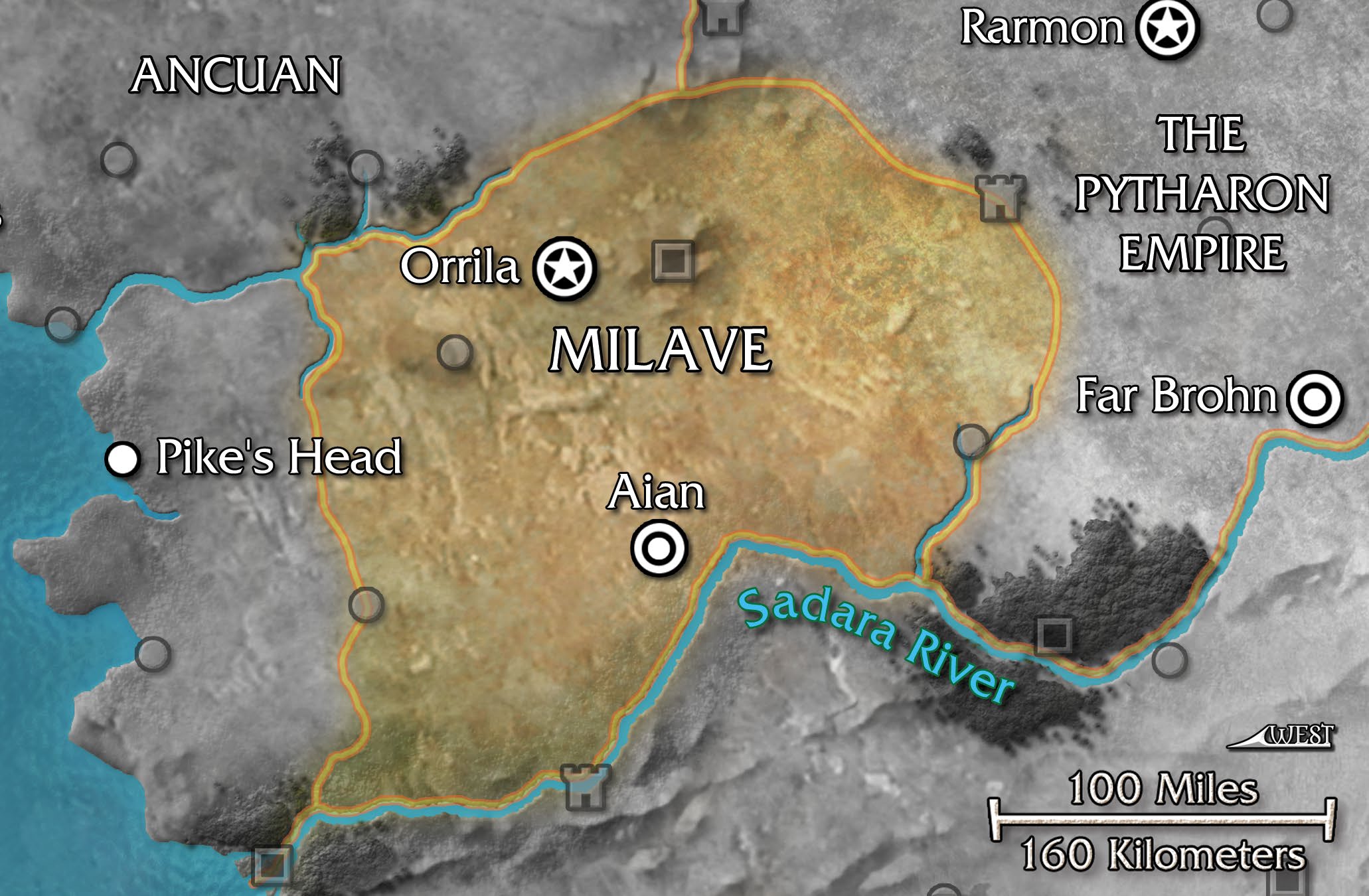
Most people of Milave are farmers who produce a variety of foodstuffs as well as an herb called ghianche, or sometimes just ganch. It fills many pipes throughout the region, and it’s sometimes rolled into cigars as well. The herb is a mild relaxant, but when treated with certain chemicals, it can also be a powerful hallucinogen.
Ganch fields are difficult to maintain and require a large workforce. A few communities have repurposed a variety of numenera machines and devices to help in the labor, so it’s not uncommon to see a massive construct or automaton harvesting fields of ganch leaves.
Ruler: The Milave Council
Population: 900,000
Capital: Orrila
¶ Ancuan
A broad, fertile, and peaceful land, Ancuan is blessed on many fronts. Its rolling hills teem with bountiful herds of animals, its fields flow with produce and grains, and its long shorelines offer fish and other valuable commodities. Of course, Ancuan is not without its troubles. Pirates ply the shorelines, preying on coastal trading vessels. Bandit raiders threaten villages. Sathosh and chirog roam the countryside.
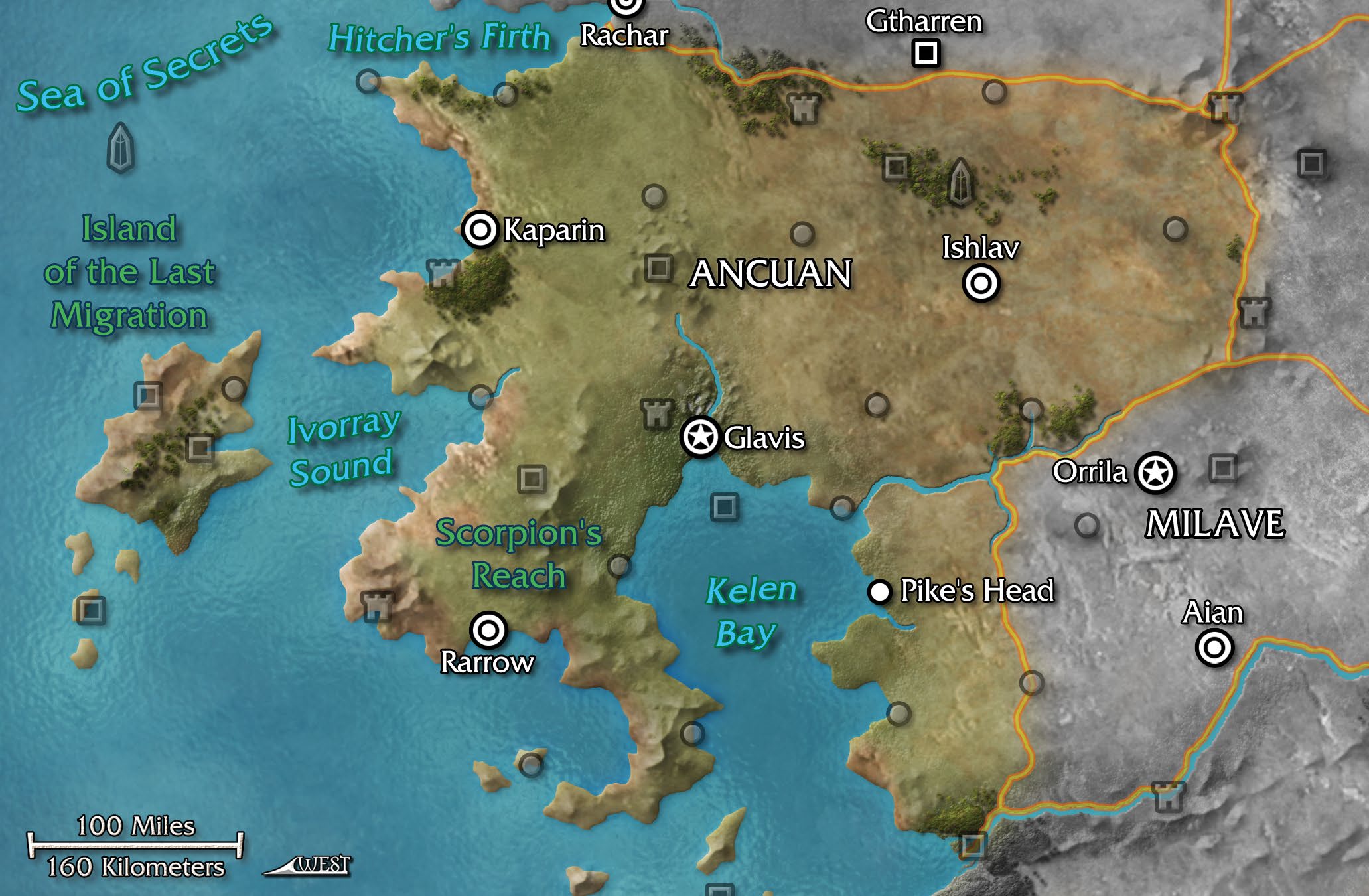
King Asour-Mantir rules from a castle of stronglass 20 miles (32 km) outside the city of Glavis. Tradition dictates that no one other than his immediate household and guard live within a radius of 10 miles (16 km), so the Transparent Palace, as it is called, stands alone in a sprawling, rocky field. The king’s extended family is large, the product of two noble houses joined in permanent alliance to ensure the stability of the land. Members of the Blue Legion, his royal guard, are renowned for their skill as archers.
The people of Ancuan are independent and self-sufficient, relying on their king for little. They make their way as sailors, fishers, arron farmers, yol herders, and salt miners.
Similar to how Angulan Knights throughout the Steadfast have tamed xi-drakes to use as flying mounts, the people of Ancuan sometimes ride rasters—large, biomechanical, bat-like creatures native to the region. Often the rasterriders, or “rastriders,” are loners who live along the coast. Some, however, join raider or pirate groups, training their fellows to be rastriders. A sky filled with brigands mounted on giant hover-bats can be a terrifying sight indeed. (On the other hand, an aerial battle between a rastrider raider and an Angulan Knight is a memory no witness would soon forget.)
Ruler: King Asour-Mantir
Population: 1,500,000
Capital: Glavis
¶ The Beyond
The Beyond is a very Steadfast-centric term, used essentially to describe any area of the world that isn’t part of the nine kingdoms. As the scope of the world known and understood by even the most learned scholars in the Steadfast is limited, however, what the Beyond technically includes are the lands south of the Caecilian Jungle, west of the Clock of Kala, and north of the Southern Wall.
The people of the Beyond are even more disparate and isolated from one another than the folk of the Steadfast are. Although these lands are full of would-be rulers, most communities are truly independent. Many have little contact with the world outside their own limited bounds, and some have none at all. The scattered villages of the Beyond are called aldeia, and most are centered on a clave of Aeon Priests.
Due to the perils of the Ninth World, many aldeia don’t welcome strangers. Some of these villages are dangerous in and of themselves, as the inhabitants have taken up cannibalism, human sacrifice, or similar practices.
